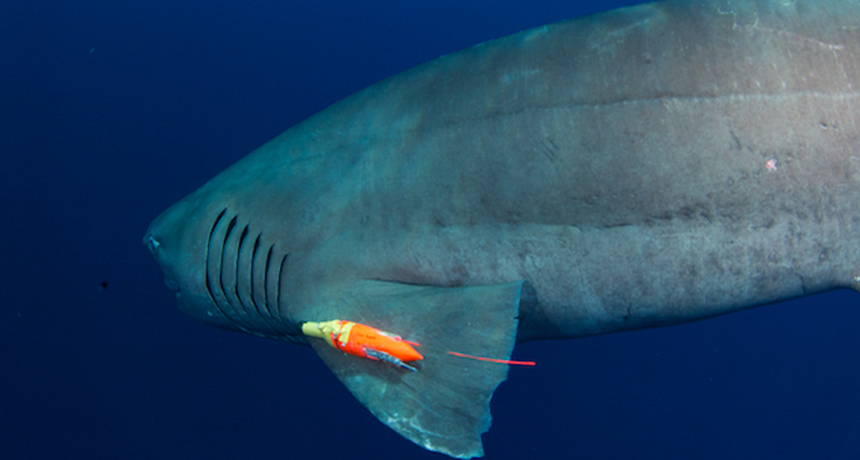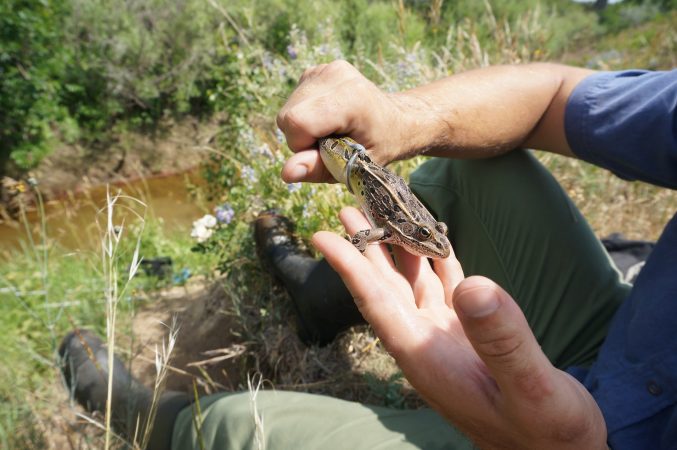Explainer: Tagging through history
Initially just little metal bands with numbers, wildlife tags have evolved dramatically in recent decades

The tag on this shark’s fin will eventually come loose and float to the surface. Later, biologists will retrieve it and download the data it collected on the fish’s travels.
Carl Meyer
By Susan Moran
Scientists have been tagging wild animals for hundreds of years. The earliest devices consisted of little more than a rugged metal band. Biologists marked each band with a unique identification number. Once attached to the leg, ear or other part of the body of some critter, it became the animal’s “name.” Once released back into the wild, that animal might wear its nametag for a decade or longer. Every time it was recaptured, scientists knew who it was.
Eventually, biologists created lighter tags to identify, or ID, more delicate creatures. A monarch butterfly, for instance, might receive a paper tag glued onto its wing. (Check out Monarch Watch to learn about student tagging projects in your area.)
In the 1950s, radio telemetry transformed tagging. It allowed a tagged animal to broadcast its presence with a radio signal. Scientists carried around a “receiver.” Its antenna would pick up the signals from a tag. That allowed scientists to pinpoint the location of a tagged animal.
About the only information these tags could send were an animal’s whereabouts. Still, that can prove quite valuable in helping to recapture a known animal. Indeed, it’s the type of tag that Maxwell Joseph of the University of Colorado uses. Each tag that he straps onto a leopard frog costs about $150.

In the late 1970s, animal tagging advanced further with the launching of the Argos satellite system. After placing an electronic collar or other device on an animal, the special tag emits a radio signal that can be picked up by satellites. Satellites can then home in on the animal’s location and relay it to some base station on Earth. A scientist can then retrieve these data from the Internet. Or researchers can arrange to have the data shipped to their email accounts.
More recently, in the 1990s, global positioning system, or GPS, technology joined the mix of tagging tools. Satellites in a fixed and stationary orbit overhead regularly send out signals — pings — that an animal’s tag can recognize. Using the steady pings from three or more satellites, the tag calculates its geographic location on Earth’s surface.
Even newer on the horizon: Some tags include a package of electronic devices. Those being attached to Burmese pythons slithering through the Florida Everglades, for instance, sometimes include an accelerometer. It can record a snake’s movements in three dimensions. Why? A rolling motion in a fairly stationary spot may indicate the snake is coiling up and slowly constricting — suffocating its prey. Such motions will identify where and how often these well-camouflaged animals dine. And that’s useful information for tracking a species where healthy adults can go up to a year between meals.
Power Words
accelerometer An instrument for measuring vibrations or a change in the rate of movement. The one being used with snakes can measure movement changes in all three dimensions.
amphibian Cold-blooded vertebrate animal of a class that includes frogs, toads, newts and salamanders. They are distinguished by having an aquatic gill-breathing larval stage typically followed by a terrestrial lung-breathing adult stage.
Argos A satellite-based system that collects, processes and disseminates environmental data from fixed and mobile platforms worldwide.
GPS Abbreviation for global positioning system.
GPS device Devices that calculate their position (in terms of latitude and longitude) from any place on the ground or in the air. They do this by comparing how long it takes signals from different satellites to reach them.
predator (adjective: predatory) A creature that preys on other animals for most or all of its food.
prey Animal species eaten by others.
radio To send and receive radio waves; or the device that receives those transmissions.
radio tracking Following the movements of an animal or object using a device that gives off radio waves. A receiver can pick up those radio-frequency waves to provide information on how far away the broadcasting signal is and in which direction. Many biologists implant devices into animals that broadcast such radio-wave signals to keep track of the tagged individual in the wild.
rookery A place where birds or animals, such as penguins and seals, nest or breed. The term stems from the word “rook,” which is an ancient bird that looks like the North American crow and nests in colonies near the tops of trees.
telemetry A form of wireless communication in which measurements such as geographic location are collected, stored in a device and then transmitted to a receiver somewhere else.







